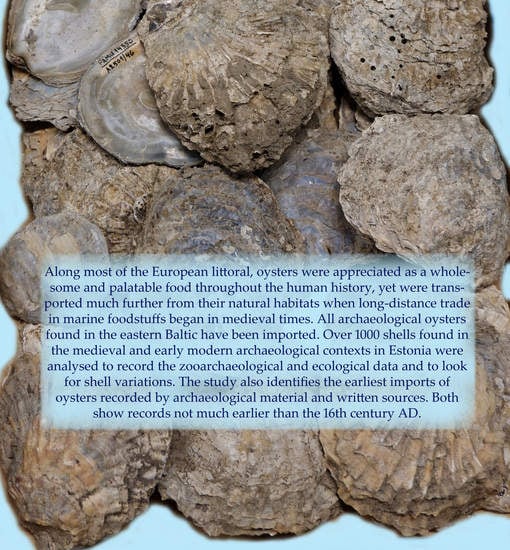European Flat Oyster (Ostrea Edulis L.) in the Eastern Baltic as Evidence of Long-Distance Trade in Medieval and Early Modern Times
Abstract
:1. Introduction
2. Archaeological Evidence of Oysters in Estonia
2.1. Methods of Collection and Research
2.2. Material
2.3. Results of the Analysis of Oyster Shells
2.4. Variation in Oyster Shell Characteristics
3. Historical Evidence of Oysters in Estonia
4. Discussion
5. Conclusions
Supplementary Materials
Author Contributions
Funding
Institutional Review Board Statement
Informed Consent Statement
Data Availability Statement
Acknowledgments
Conflicts of Interest
References
- Campbell, G. “What do I do with all these shells?” Basic guidance for the recovery, processing and retention of archaeological marine shells. Quat. Int. 2017, 427, 13–20. [Google Scholar] [CrossRef]
- Andersen, S.; Johansen, E. Ertebølle revisited. J. Dan. Archaeol. 1986, 5, 31–61. [Google Scholar] [CrossRef]
- Andersen, S. Kökkenmöddinger (Shell Middens) in Denmark: A Survey. Proc. Prehist. Soc. 2000, 66, 361–384. [Google Scholar] [CrossRef]
- Fischer, A.; Kristiansen, K. (Eds.) The Neolithisation of Denmark: 150 Years of Debate; J. R. Collis Publications: Sheffield, UK, 2002. [Google Scholar]
- Fischer, A.; Gotfredsen, A.B.; Meadows, J.; Pedersen, L.; Stafford, M. The Rödhals kitchen midden—Marine adaptation at the end of the Mesolithic world. J. Archaeol. Sci. Rep. 2021, 39, 103102. [Google Scholar] [CrossRef]
- Bērziņš, V.; Brinker, U.; Klein, C.; Lübke, H.; Meadows, J.; Rudzīte, M.; Schmölke, U.; Stümpel, H.; Zagorska, I. New research at Riņņukalns, a Neolithic freshwater shell midden in northern Latvia. Antiquity 2014, 88, 715–732. [Google Scholar] [CrossRef]
- Tvauri, A. The Migration Period, Pre-Viking Age, and Viking Age in Estonia; Estonian Archaeology 4; Tartu University: Tartu, Estonia, 2012. [Google Scholar]
- Valk, H.; Laul, S. Siksälä Kalme I. Muistis ja Ajalugu; Tartu University: Tartu, Estonia, 2014. [Google Scholar]
- Bennema, F.P.; Engelhard, G.H.; Lindeboom, H. Ostrea edulis beds in the central North Sea: Delineation, ecology and restoration. J. Mar. Sci. 2020, 77, 2694–2705. [Google Scholar] [CrossRef]
- Pogoda, B. Current Status of European Oyster Decline and Restoration in Germany. Humanities 2019, 8, 9. [Google Scholar] [CrossRef] [Green Version]
- Winder, J.M. Oysters in Archaeology. In Molluscs in Archaeology: Methods, Approaches and Applications; Allen, M.J., Ed.; Oxbow Books: Oxford, UK, 2017; pp. 238–258. [Google Scholar]
- Hayer, S.; Bick, A.; Brandt, A.; Ewers-Saucedo, C.; Fiege, D.; Füting, S.; Krause-Kyora, B.; Michalik, P.; Reinicke, G.-B.; Brandis, D. Coming and going—Historical distributions of the European oyster Ostrea edulis Linnaeus, 1758 and the introduced slipper limpet Crepidula fornicata Linnaeus, 1758 in the North Sea. PLoS ONE 2019, 14, e0224249. [Google Scholar] [CrossRef] [PubMed]
- Seaman, M.N.L.; Ruth, M. The molluscan Fisheries of Germany. In U.S. Department Commerce, NOAA Technical Report NMFS; Fisheries Agency: Kiel, Germany, 1997; Volume 129, pp. 57–84. [Google Scholar]
- Lõugas, L.; Russow, E. Dataset of the finds of oyster’s shells in Estonian archaeological collections. Repos. Res. Data 2022. [Google Scholar] [CrossRef]
- Hansen, C.P. Chronik der Freischisen Uthlande; Verlag, H. Lühr & Dircks: Garching, Germany, 1877. [Google Scholar]
- Winder, J.M. Oysters and Other Marine Shells. In Heybridge: A Late Iron Age and Roman Settlement, Excavations at Elms Farm 1993-95; Atkinson, M., Preston, S.J., Eds.; Internet Archaeology; Department of Archaeology, University of York: York, UK, 2015; Volume 40. [Google Scholar] [CrossRef]
- Russow, E.; Valk, H.; Haak, A.; Pärn, A.; Mäesalu, A. Medieval archaeology of European context: Towns, churches, monasteries and castles. In Archaeological Research in Estonia 1865–2005; Estonian Archaeology, 1; Lang, V., Laneman, M., Eds.; Tartu University Press: Tartu, Estonia, 2006; pp. 159–192. [Google Scholar]
- Russow, E. Post-Medieval Archaeology in Estonia. In Archaeological Research in Estonia 1865–2005; Estonian Archaeology, 1; Lang, V., Laneman, M., Eds.; Tartu University Press: Tartu, Estonia, 2006; pp. 193–203. [Google Scholar]
- Russow, E.; Tourigny, E.; Newstead, S.; Russow, E.; Ose, I.; Urbonaité-Ubém, M. Global post-medieval/historical archaeology: The Baltic states. Post-Mediev. Archaeol. 2021, 55, 432–441. [Google Scholar] [CrossRef]
- Winder, J.M. Oyster Shells from Archaeological Sites: A Brief Illustrated Guide to Basic Processing. Online manual. 2011. Available online: https://oystersetcetera.wordpress.com/2011/03/29/oyster-shells-from-archaeological-sites-a-brief-illustrated-guide-to-basic-processing (accessed on 10 March 2022).
- Campbell, G. Oysters ancient and modern: Potential shape variation with habitat in flat oysters (Ostrea edulis L.) and its possible use in archaeology. In Not Only Food; Special Issue; Alvares-Fernandes, E., Carvajal Contreras, D., Eds.; Munibe: Donostia-San Sebastian, Spain, 2010; Volume 31, pp. 176–187. [Google Scholar]
- Thomas, R.; Law, M.; Browning, E.; Hill, H.; Small, R. The Changing Exploitation of Oysters (Ostrea edulis L. 1758) in Late Medieval and Early Modern England: A Case Study of Dudley Castle, West Midlands. Environ. Archaeol. J. Hum. Palaeoecol. 2020, 25, 82–95. [Google Scholar] [CrossRef]
- Campbell, G. Beyond means to meaning: Using distributions of shell shapes to reconstruct past collecting strategies. Environ. Archaeol. 2008, 13, 111–121. [Google Scholar] [CrossRef]
- Milner, N. At the Cutting Edge: Using Thin Sectioning to Determine Season of Death of the European Oyster. Ostrea Edulis. J. Archaeol. Sci. 2001, 28, 861–873. [Google Scholar] [CrossRef]
- Bruns, F.; Weczercka, H. Atlas. Quellen und Darstellungen zur hansischen Geschichte. In Hansische Handelsstrassen; Neue Folge Band XIII (1); Böhlau: Köln, Graz, 1962. [Google Scholar]
- Lõugas, L.; Vedru, G. Kas pidu katku ajal? Pidulikule söömaajale viitavad leiud Uus-Pärnust. In Muinasaja Teadus = Research into Ancient Times, Ilusad Asjad, Põnevad Lood; Tartu University Press: Tartu-Tallinn, Estonia, 2022; in print. [Google Scholar]
- Waselkov, G.A. Shellfish gathering and shell midden archaeology. In Advances in Archaeological Method and Theory; Schiffer, M.B., Ed.; Academic Press: New York, NY, USA, 1987; pp. 93–210. [Google Scholar]
- Rosser, S.R.; Rick, T.C. Shucked, Cracked, Steamed, or Roasted? Archaeological Experiments in Processing and Butchering the Eastern Oyster Poster 2012. Available online: https://naturalhistory.si.edu/sites/default/files/media/file/2012-rosser-poster.pdf (accessed on 10 March 2022).
- Documents in the Tallinn City Archives: 230.1.Ba35/II.
- Documents in the Tallinn City Archives: 230.1.Ba35/III.
- Documents in the Tallinn City Archives: 230.1.Ba7.
- Kaju, K. Pärnu city customs books in the Estonian Historical Archives (1764–1782). Tartu: Kirjastus Eesti Ajalooarhiiv, 2006: Stadts-Zulage-Journal, 1781–1782. Available online: https://www.ra.ee/wp-content/uploads/2017/12/1781_1782.pdf (accessed on 10 January 2022).
- Hupel, A.W. Topographische Nachrichten von Lief-und Ehstland; Bd. II, J. F. Hartknoch: Riga, Letonia, 1777. [Google Scholar]
- Documents in the National Archives of Estonian (RA): EAA 3339.1.2025; 3339.1.2097; 3339.1.2503; 3339.1.3537.
- Verril, A.E. How long will oysters live out of water? Bull. United States Fish Comm. 1885, V/11, 161–162. [Google Scholar]
- Kaju, K. Pärnu City Customs Books in the Estonian Historical Archives (1764–1782). Tartu: Kirjastus Eesti Ajalooarhiiv, 2006: Stadts-Zulage-Journæle der Kayserl. Stadt Pernau, 1776–1777. Available online: https://www.ra.ee/wp-content/uploads/2017/12/1777.pdf (accessed on 10 January 2022).
- Hansen, A.U. Charakterbilder aus den Herzogthümern Schleswig, Holstein und Lauenberg; Verlag von Gustav Carl Würger: Hamburg, Germany, 1858. [Google Scholar]
- Kaju, K. Pärnu City Customs Books in the Estonian Historical Archives (1764–1782). Tartu: Kirjastus Eesti Ajalooarhiiv, 2006: Der Kayserl. Stadt Pernau Zulage Journal. 1766. Available online: https://www.ra.ee/wp-content/uploads/2017/12/1766.pdf (accessed on 10 January 2022).
- Kaju, K. Pärnu city customs books in the Estonian Historical Archives (1764–1782). Tartu: Kirjastus Eesti Ajalooarhiiv, 2006: Pernausches Stadt-Zulage-Journal. 1764. Available online: https://www.ra.ee/wp-content/uploads/2017/12/1764.pdf (accessed on 10 January 2022).
- Bernotas, R.; Randoja, K.; Tvauri, A. Archaeological research in the area between Pärnu Road and Peeter Süda Street in Tallinn. Archaeol. Fieldwork Est. 2017, 2016, 155–162. [Google Scholar]
- Bernotas, R.; Randoja, K.; Tvauri, A.; Russow, E. Archaeological excavations at Harju Gate suburb in Tallinn, Tatari St. 13/Sakala St. 13, 15 and 17. Archaeol. Fieldwork Est. 2018, 2017, 165–174. [Google Scholar]
- Russow, E.; Randoja, K.; Bernotas, R.; Tvauri, A.; Rammo, R.; Reppo, M.; Ratas, J.; Kreem, J.; Lõugas, L. A late medieval treasure trove of Tallinn. Salvage excavations of the 15th-century landfill between the Jahu and Väike-Patarei streets. Archaeol. Fieldwork Est. 2019, 2018, 185–218. [Google Scholar]
- Leimus, I.; Tvauri, A. Coins and tokens from a 15th-century landfill in the Kalamaja suburb of Tallinn. Est. J. Archaeol. 2021, 25, 140–159. [Google Scholar] [CrossRef]
- Tamla, Ü. Pärnu Munga t. 2 krundi arheoloogiliste kaevamiste aruanne 1990. a. Excavation report in the archives of the Archaeological Research Collection of Tallinn University (document no. AI-22-67-12). 1990. [Google Scholar]
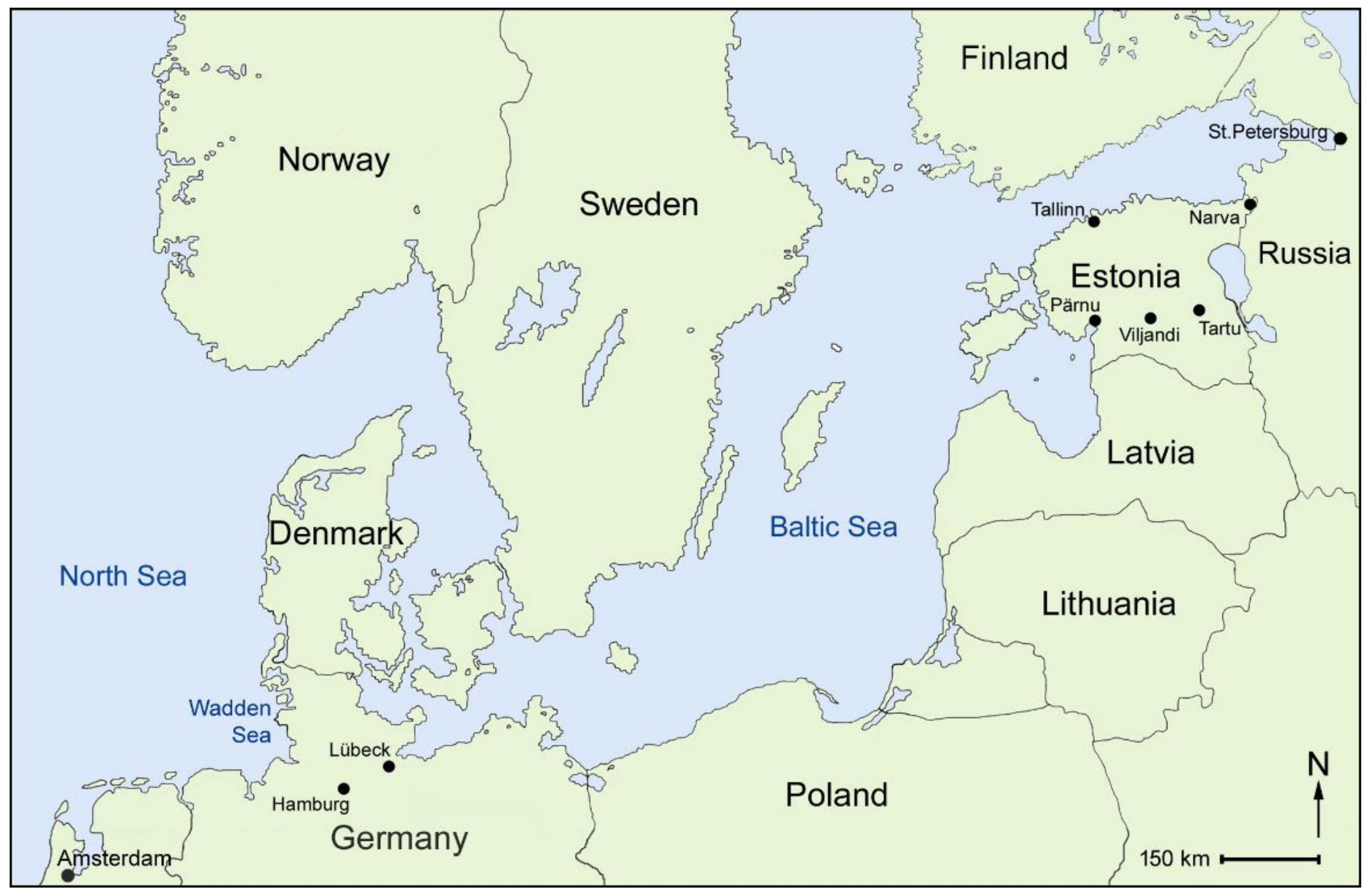
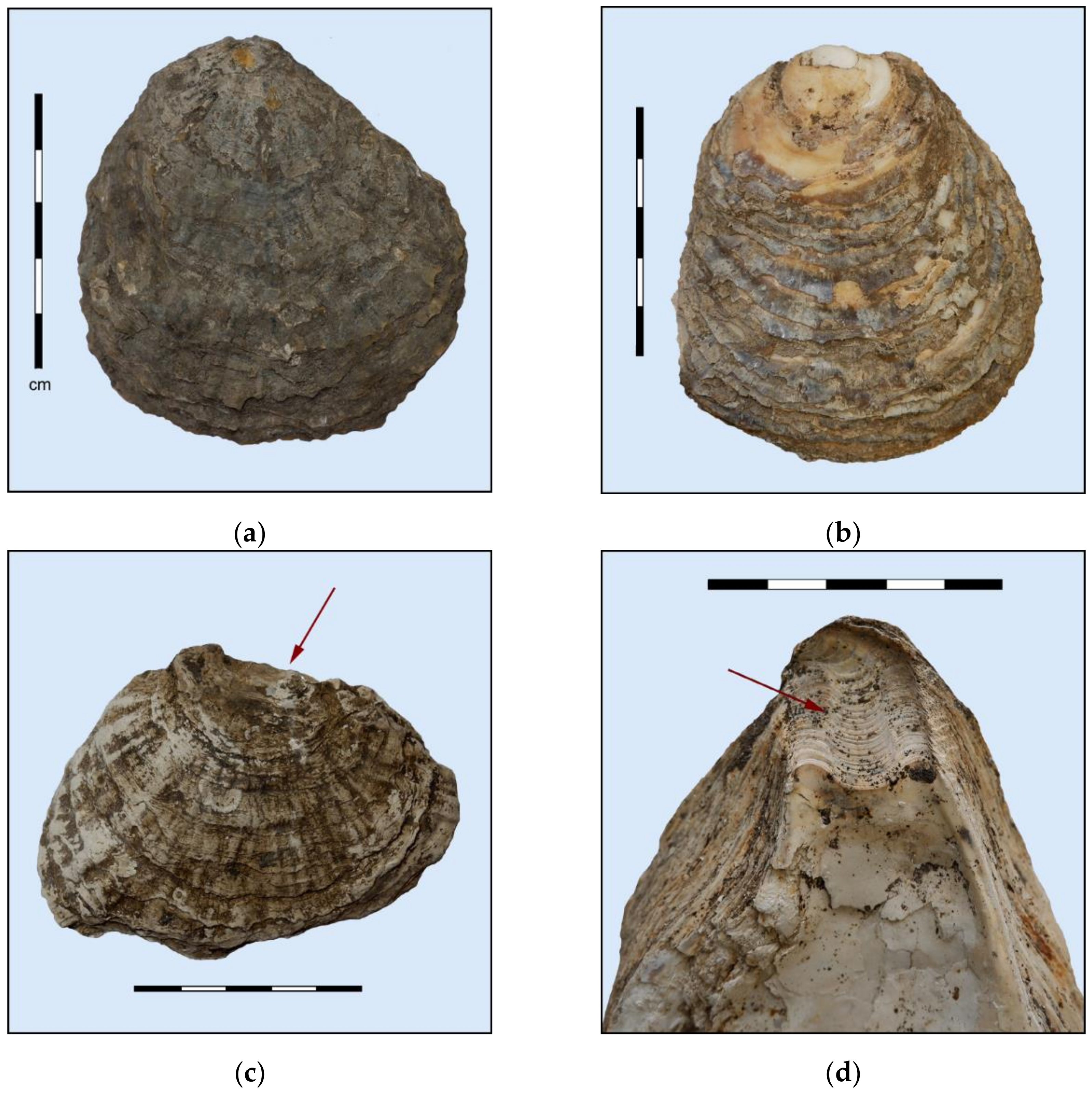
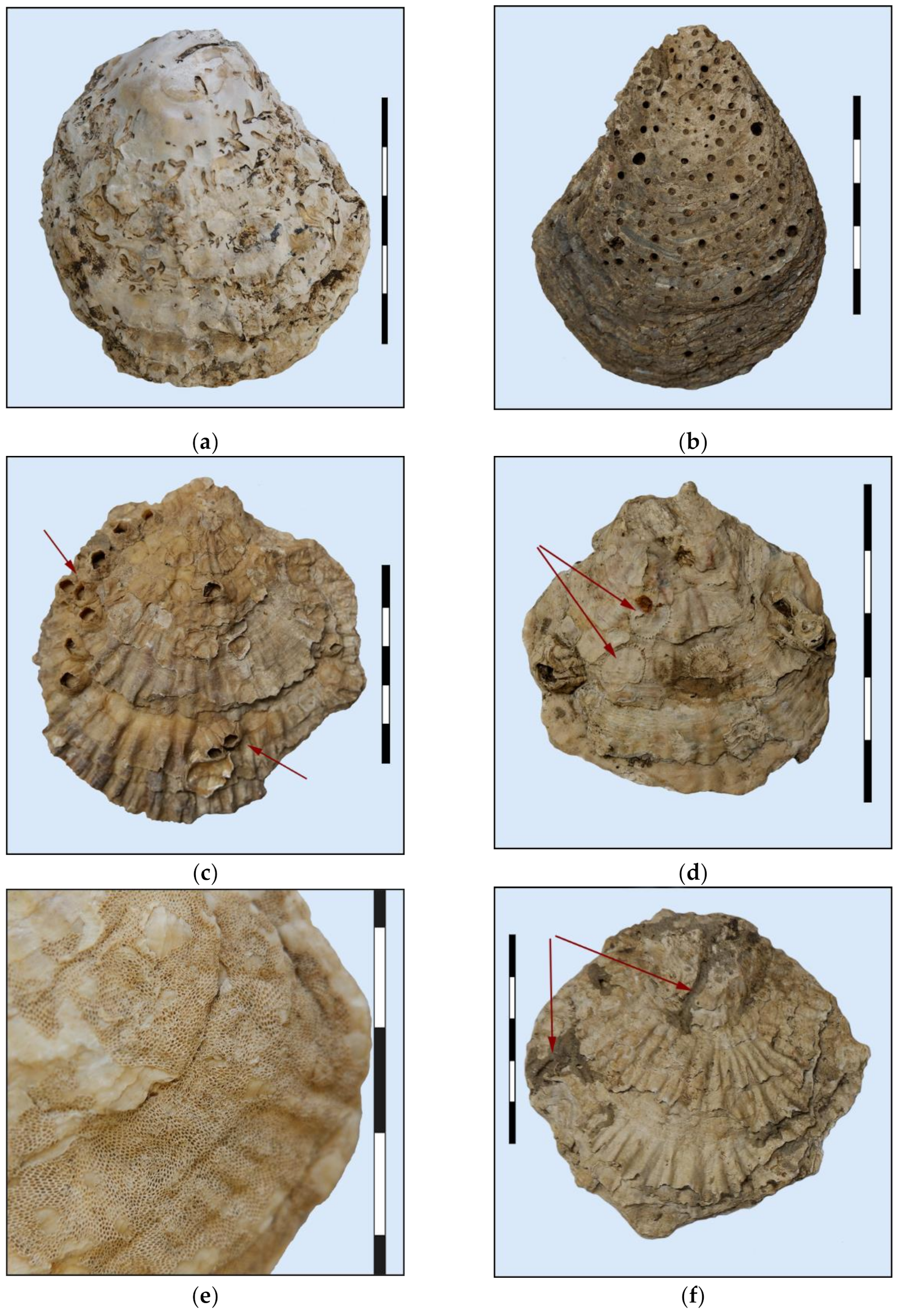
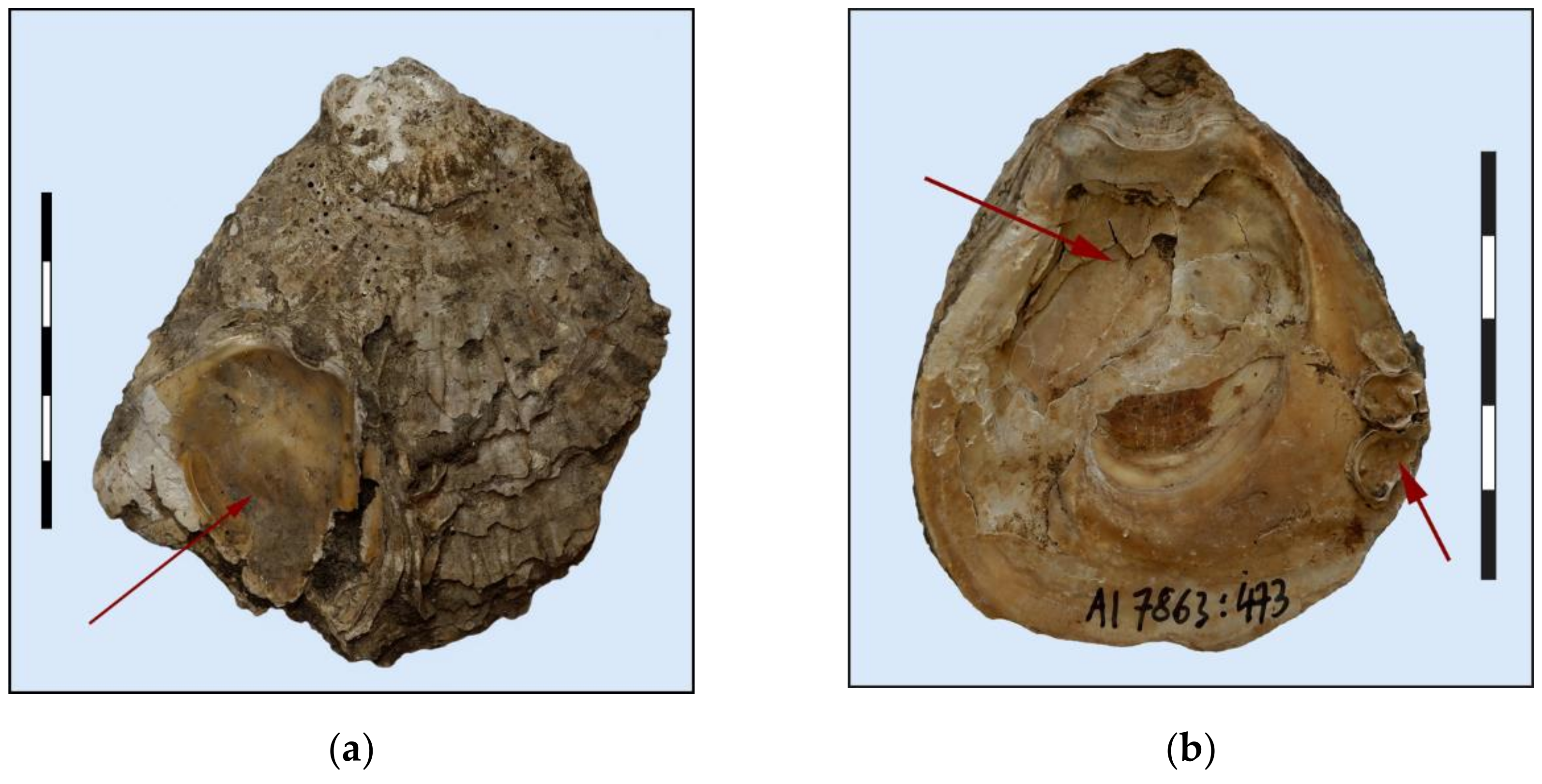
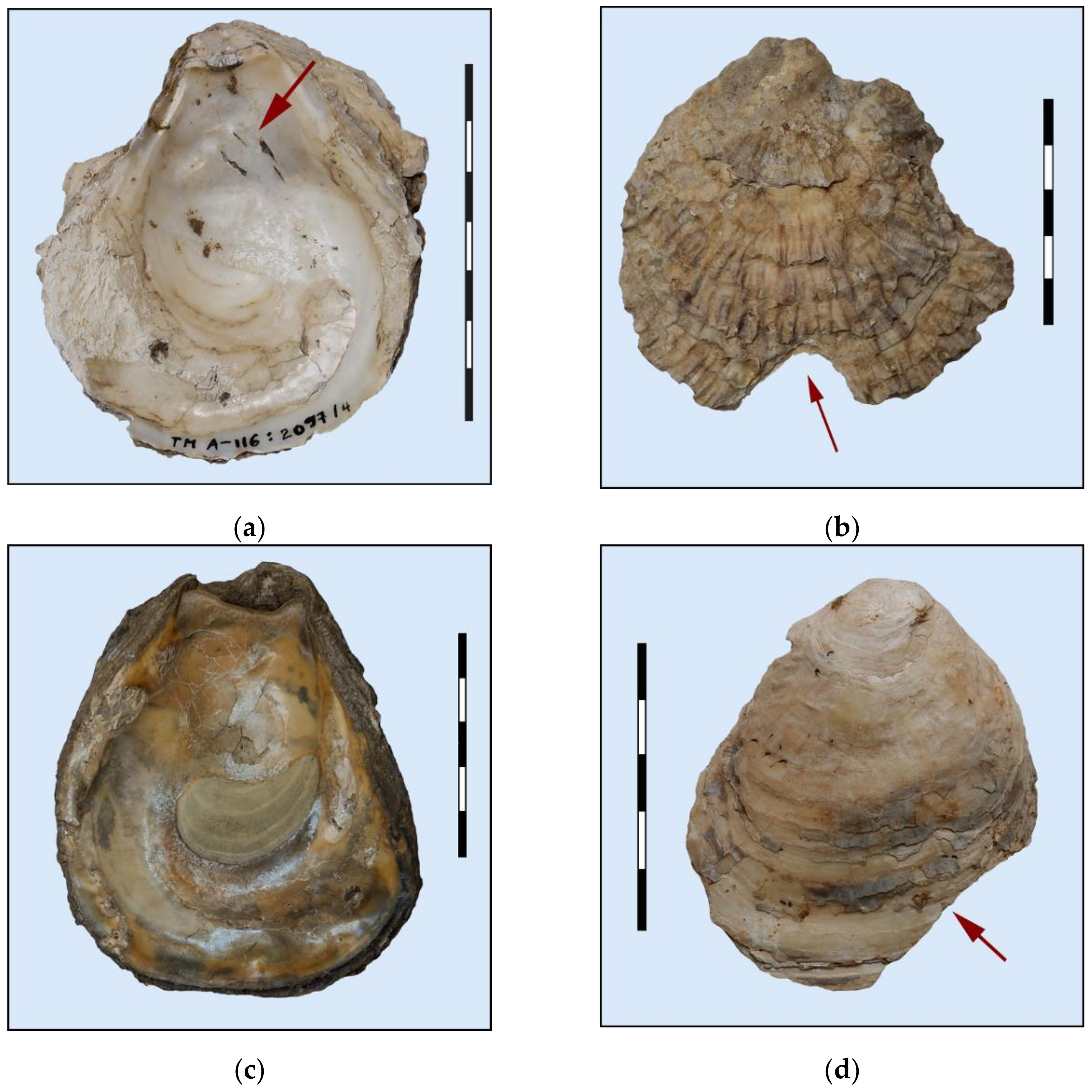
| Location | Date by the Context | NISP 1 S/D | NISP 2 | Valve H (mm) min–max | Valvel L (mm) min–max |
|---|---|---|---|---|---|
| Tallinn (45 sites) | 15th–16th century | 3/2 | 29 | 46–111 | 64–103 |
| 16th–17th century | 25/28 | 24 | 44–112 | 39–98 | |
| 18th–19th century | 44/54 | 31 | 35–107 | 31–101 | |
| N/A (14th–19th c.) | 24/36 | 63 | 41–108 | 33–95 | |
| Tartu (19 sites) | 16th–17th century | 5/6 | 5 | 62–85 | 55–68 |
| 18th–19th century | 79/88 | 15 | 47–121 | 44–100 | |
| Pärnu (7 sites) | 15th–16th century | 0/1 | 4 | 78 | 80 |
| 16th–17th century | 85/84 | 38 | 50–106 | 43–100 | |
| 18th–19th century | 175/254 | 93 | 41–117 | 34–109 | |
| Other | 17th–19th century | ca. 30 | N/A | N/A |
Publisher’s Note: MDPI stays neutral with regard to jurisdictional claims in published maps and institutional affiliations. |
© 2022 by the authors. Licensee MDPI, Basel, Switzerland. This article is an open access article distributed under the terms and conditions of the Creative Commons Attribution (CC BY) license (https://creativecommons.org/licenses/by/4.0/).
Share and Cite
Lõugas, L.; Jürjo, I.; Russow, E. European Flat Oyster (Ostrea Edulis L.) in the Eastern Baltic as Evidence of Long-Distance Trade in Medieval and Early Modern Times. Heritage 2022, 5, 813-828. https://doi.org/10.3390/heritage5020044
Lõugas L, Jürjo I, Russow E. European Flat Oyster (Ostrea Edulis L.) in the Eastern Baltic as Evidence of Long-Distance Trade in Medieval and Early Modern Times. Heritage. 2022; 5(2):813-828. https://doi.org/10.3390/heritage5020044
Chicago/Turabian StyleLõugas, Lembi, Inna Jürjo, and Erki Russow. 2022. "European Flat Oyster (Ostrea Edulis L.) in the Eastern Baltic as Evidence of Long-Distance Trade in Medieval and Early Modern Times" Heritage 5, no. 2: 813-828. https://doi.org/10.3390/heritage5020044
APA StyleLõugas, L., Jürjo, I., & Russow, E. (2022). European Flat Oyster (Ostrea Edulis L.) in the Eastern Baltic as Evidence of Long-Distance Trade in Medieval and Early Modern Times. Heritage, 5(2), 813-828. https://doi.org/10.3390/heritage5020044






